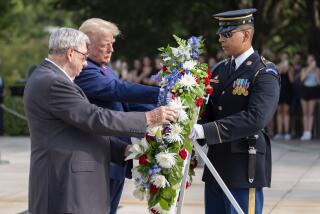Union Jack Marks the Spot Where 23 Royal Air Force Cadets Lie : British Airmen Died Far From Home, but Florida Town Remembers
- Share via
ARCADIA, Fla. — The British Union Jack, fading in the relentless Florida sun and flapping in the gentle breeze, looks strangely out of place amid the palms and sand of the Oak Ridge Cemetery.
It flies above 23 tombstones bearing the names of 23 peach-fuzz-faced Royal Air Force cadets who met death during World War II--death that came an ocean away from the real battles as they hastily learned to fly.
On Memorial Day, the residents of Arcadia, a quiet cow town 40 miles from the Gulf of Mexico, will gather the way they have for more than three decades to honor the British airmen who never made it home.
“There’s something unique about it,” said Tim Adamson, editor of the Arcadian, the local weekly newspaper. “Here’s a little bit of foreign soil tucked right here in the middle of citrus and cattle country. It’s a little bit of England.”
Said Richard Wood, 70, a retired high school teacher who has been coordinating the annual Memorial Day service on behalf of the Arcadia Rotary Club since 1972: “There’s quite a lot of pride in the town about this. We really feel good about it.”
Longstanding British tradition stated that British soldiers were to be buried where they fell. In the United States, there are 952 identified British graves at 448 sites, according to the Commonwealth War Graves Commission. Arcadia’s Oak Ridge Cemetery, with the 23 British graves nestled among the burial sites of local residents, contains one of the largest congregations of British war dead.
But it is the manner in which the townsfolk of Arcadia, 90 miles southeast of Tampa, have opened their hearts to the fallen cadets that sets this place apart.
Starting in 1956--and every year since--Arcadia has held a Memorial Day service at the cemetery for the British fliers, an exceptional touch since Britain does not celebrate America’s Memorial Day and few residents remain with personal recollections of the cadets.
Each of the modest tombstones, set in two rows shaded by trees, is adorned with miniature Union Jacks and flowers for the service. British officials routinely attend the ceremony, as do visitors from Canada and World War II veterans from elsewhere in Florida. The service features bagpipes and the singing of patriotic songs that Britain and the United States share in tune if not words--”God Save the Queen” and “America.”
Arcadia officials stay in contact with the cadets’ next of kin each year and keep the British plot neatly maintained. Until recently, when the last elderly flag-keeper died, Arcadia residents raised and lowered the Union Jack every morning and evening. While the search is on for another volunteer, the flag flies 24 hours a day.
“You read so much in the paper that’s so bloody awful these days that it’s nice to see people doing nice things like this,” said Jill Cooper, a spokeswoman for the British Consul General in Atlanta. “I know the families of these young boys feel good knowing their graves are being taken care of.”
The cadets buried in Arcadia were among 15,000 British troops trained in aerial warfare in the United States during World War II. They were shipped across the Atlantic simply because there was no place closer to home where they could train without being thrust into battle.
Ironically, these 23 cadets--all assigned to Florida airfields and most still in their teens--died in the cause of war without firing a shot. Nineteen were killed in training flight crashes that were blamed on primitive aircraft and overzealous young pilots eager to learn too much in too little time. Two died in a car accident, another of meningitis and still another of pneumonia. By homeland, there were 18 Englishmen, two Scots, two Welshmen and an Irishman.
The terrible sadness of these stories--young men killed so far from home for a war they never saw--is arresting. The grief leaps from the tombstones engraved with epitaphs composed by the parents, none of whom ever set foot in Arcadia.
“To think we were not near to keep one vigil o’er thy bed,” reads the tombstone of Thomas J. Parry.
The grave marker for C.F. (Beano) Russell reads in simple eloquence, “Farewell till we meet. Dads and Mums.”
More than 40 years later, a teen-age girl wanders among the British graves on a brilliant spring day, quietly reading the tombstones and absorbing the mournful history that weighs heavy at Oak Ridge Cemetery.
Michelle Goodson, 17, a senior at nearby DeSoto High School, explains that she stumbled upon the final resting place of these British fliers when she visited the cemetery to mourn the loss of a friend. Whenever she visits the cemetery, she always makes time to stop by the British graves.
“It’s interesting to me,” Goodson said. “They were so young, and they gave up their lives for a free country. I’m going into the military in a few weeks, so what they did really means something to me.”
Goodson finds the burial place of these young airmen a perfect place for thought.
“I like the quiet,” she said. “It’s inspiring to me. They died for their country.”
More to Read
Sign up for The Wild
We’ll help you find the best places to hike, bike and run, as well as the perfect silent spots for meditation and yoga.
You may occasionally receive promotional content from the Los Angeles Times.






